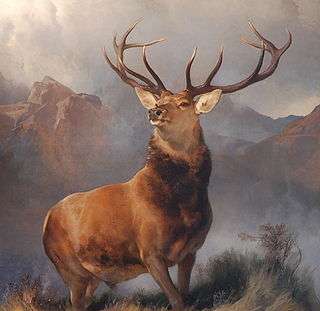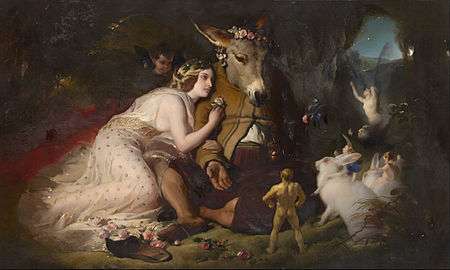Edwin Henry Landseer
| Sir Edwin Henry Landseer | |
|---|---|
 Portrait by Sir Francis Grant (1852) | |
| Born |
7 March 1802 London, England |
| Died |
1 October 1873 (aged 71) London, England |
| Nationality | English |
| Education | Royal Academy Schools, London, England |
| Known for | Painting, sculpture |
| Movement | Animalier |
| Awards | Great gold medal of the Exposition Universelle (1855), Paris, France |
Sir Edwin Henry Landseer RA (7 March 1802 – 1 October 1873) was an English painter,[1] well known for his paintings of animals—particularly horses, dogs and stags. However, his best known works are the lion sculptures in Trafalgar Square.
Life

Landseer was born in London, the son of the engraver John Landseer A.R.A.[2] He was something of a prodigy whose artistic talents were recognised early on. He studied under several artists, including his father, and the history painter Benjamin Robert Haydon, who encouraged the young Landseer to perform dissections in order to fully understand animal musculature and skeletal structure. Landseer's life was entwined with the Royal Academy. At the age of just 13, in 1815, he exhibited works there. He was elected an Associate at the age of 24, and an Academician five years later in 1831. He was knighted in 1850, and although elected President in 1866 he declined the invitation.
In his late 30s Landseer suffered what is now believed to be a substantial nervous breakdown, and for the rest of his life was troubled by recurring bouts of melancholy, hypochondria, and depression, often aggravated by alcohol and drug use.[3] In the last few years of his life Landseer's mental stability was problematic, and at the request of his family he was declared insane in July 1872.
Painting

Landseer was a notable figure in 19th-century British art, and his works can be found in Tate Britain, the Victoria and Albert Museum, Kenwood House and the Wallace Collection in London. He also collaborated with fellow painter Frederick Richard Lee.
Landseer's popularity in Victorian Britain was considerable, and his reputation as an animal painter was unrivalled.[2] Much of his fame—and his income—was generated by the publication of engravings of his work, many of them by his brother Thomas.[4]

His appeal crossed class boundaries: reproductions of his works were common in middle-class homes, while he was also popular with the aristocracy. Queen Victoria commissioned numerous pictures from the artist. Initially asked to paint various royal pets, he then moved on to portraits of ghillies and gamekeepers, Then, in the year before her marriage, the queen commissioned a portrait of herself, as a present for Prince Albert.[5] He taught both Victoria and Albert to etch,[6] and made portraits of Victoria's children as babies, usually in the company of a dog.[7] He also made two portraits of Victoria and Albert dressed for costume balls, at which he was a guest himself.[8] One of his last paintings was a life-size equestrian portrait of the Queen, shown at the Royal Academy in 1873, made from earlier sketches.[9]

Landseer was particularly associated with Scotland, which he had first visited in 1824 and the Highlands in particular, which provided the subjects (both human and animal) for many of his important paintings.[10] The paintings included his early successes The Hunting of Chevy Chase (1825–6), An Illicit Whisky Still in the Highlands (1826–9) and his more mature achievements, such as the majestic stag study Monarch of the Glen (1851) and Rent Day in the Wilderness (1855–68).[11] In 1828, he was commissioned to produce illustrations for the Waverley Edition of Sir Walter Scott's novels.[10]

So popular and influential were Landseer's paintings of dogs in the service of humanity that the name Landseer came to be the official name for the variety of Newfoundland dog that, rather than being black or mostly black, features a mix of both black and white. It was this variety Landseer popularised in his paintings celebrating Newfoundlands as water rescue dogs, most notably Off to the Rescue (1827), A Distinguished Member of the Humane Society (1838), and Saved (1856). The paintings combine the Victorian conception of childhood with the appealing idea of noble animals devoted to humankind, a devotion indicated, in Saved, by the fact the dog has rescued the child without any apparent human involvement.
Landseer's painting Laying Down The Law (1840) satirises the legal profession through anthropomorphism. It shows a group of dogs, with a poodle symbolising the Lord Chancellor.[12]
The Shrew Tamed, was entered at the 1861 Royal Academy Exhibition and caused controversy because of its subject matter. It showed a powerful horse on its knees among straw in a stable, while a lovely young woman lies with her head pillowed on its flanks, lightly touching its head with her hand. The catalogue explained it as a portrait of a noted equestrienne, Ann Gilbert, applying the taming techniques of the famous 'horse whisperer' John Solomon Rarey.[13] Critics were troubled by the depiction of a languorous woman dominating a powerful animal and some concluded Landseer was implying the famous courtesan Catherine Walters, then at the height of her fame.[14] Walters was an excellent horsewoman and along with other "pretty horsebreakers", frequently appeared riding in Hyde Park.
Some of Landseer's later works, such as his Flood in the Highlands and Man Proposes, God Disposes (both of 1864) are pessimistic in tone.[2] The latter shows two polar bears toying with the bones of the dead and other remains, from Sir John Franklin's failed arctic expedition.[15] The painting was purchased at auction by Thomas Holloway and hangs in the picture gallery of Royal Holloway, University of London. It is a college tradition to cover the painting with a union jack, when exams are held in the gallery, as there is a longstanding rumour that the painting drives people mad when they sit by it.
Sculpture


In 1858 the government commissioned Landseer to make four bronze lions for the base of Nelson's Column in Trafalgar Square, following the rejection of a set in stone by Thomas Milnes. Landseer accepted on condition that he would not have to start work for another nine months, and there was a further delay when he asked to be supplied with copies of casts of a real lion he knew were in the possession of the academy at Turin. The request proved complex, and the casts did not arrive until the summer of 1860.[16] The lions were made at the Kensington studio of Carlo Marochetti,[17] who also cast them. Work was slowed by Landseer's ill health, and his fractious relationship with Marochetti. The sculptures were installed in 1867.[16]
Death
Landseer's death on 1 October 1873 was widely marked in England: shops and houses lowered their blinds, flags flew at half mast, his bronze lions at the base of Nelson's column were hung with wreaths, and large crowds lined the streets to watch his funeral cortege pass.[18] Landseer was buried in St Paul's Cathedral, London.
At his death, Landseer left behind three unfinished paintings: Finding the Otter, Nell Gwynne and The Dead Buck, all on easels in his studio. It was his dying wish that his friend John Everett Millais should complete the paintings, and this he did.[19]
Miscellaneous
Landseer was rumoured to be able to paint with both hands at the same time, for example, paint a horse's head with the right and its tail with the left, simultaneously. He was also known to be able to paint extremely quickly—when the mood struck him. He could also procrastinate, sometimes for years, over certain commissions.
The architect Sir Edwin Landseer Lutyens was named after him and was his godson—Lutyens' father was a friend of Landseer.
Gallery
- Paintings
 Scene from A Midsummer Night's Dream, c. 1850
Scene from A Midsummer Night's Dream, c. 1850_-_Lion-_A_Newfoundland_Dog_-_Google_Art_Project.jpg) Lion: A Newfoundland Dog, 1824
Lion: A Newfoundland Dog, 1824 Favourites, the Property of H.R.H. Prince George of Cambridge, 1834 to 1835
Favourites, the Property of H.R.H. Prince George of Cambridge, 1834 to 1835 The Arab Tent, 1866
The Arab Tent, 1866 A Distinguished Member of the Humane Society, exhibited 1838
A Distinguished Member of the Humane Society, exhibited 1838- The Monkey Who Had Seen the World, 1827
 Saved, 1856
Saved, 1856 A Favorite Greyhound of Prince Albert, 1841
A Favorite Greyhound of Prince Albert, 1841 Queen Victoria and her family at Windsor Castle, c. 1842
Queen Victoria and her family at Windsor Castle, c. 1842 Attachment, 1829
Attachment, 1829 Queen Victoria and Prince Albert at the Bal Costumé of 12 May 1842
Queen Victoria and Prince Albert at the Bal Costumé of 12 May 1842- Falcon, 1837
- The wild cattle of Chillingham, 1867
 Doubtful Crumbs, 1858
Doubtful Crumbs, 1858_by_Edwin_Henry_Landseer_(1802-1873).jpg) Rachel Russell, 1835
Rachel Russell, 1835 A Highland Landscape, c. 1830
A Highland Landscape, c. 1830- A Highland Breakfast, 1834
 Man Proposes, God Disposes, 1864
Man Proposes, God Disposes, 1864
See also
Notes
- ↑
 Monkhouse, William Cosmo (1885). "Landseer, Edwin Henry". In Stephen, Leslie. Dictionary of National Biography. 2. London: Smith, Elder & Co. pp. 64–68.
Monkhouse, William Cosmo (1885). "Landseer, Edwin Henry". In Stephen, Leslie. Dictionary of National Biography. 2. London: Smith, Elder & Co. pp. 64–68. - 1 2 3 A Victorian Salon: Paintings from the Russell-Cotes Art Gallery and Museum. Russell-Cotes Art Gallery in association with Lundl Humphries. 1999. ISBN 0-85331-748-8.
- ↑ Ormond, Monarch 125
- ↑ Stephens (1880), p.4
- ↑ Manson (1902), p.102
- ↑ Manson (1902), p.104
- ↑ Manson (1902), p.105
- ↑ Manson (1902), p.106
- ↑ Manson (1902), p.107
- 1 2 Hamlyn, Robin (1993). Robert Vernon's Gift. London: The Tate Gallery. p. 31. ISBN 1-85437-116-9.
- ↑ "Rent-day in the Wilderness (1868) - National Galleries Scotland".
- ↑ Manson (1902), p.101
- ↑ The Times, Saturday, May 04, 1861; pg. 12; Issue 23924; col A
- ↑ Blackwood's Edinburgh Magazine Vol. 90 (550) Aug 1861 Page 211
- ↑ Manson (1902), p.161
- 1 2 Mace, Rodney (1975). Trafalgar Square:Emblem of Empire. London: Lawrence & Wishart. pp. 107–8. ISBN 085315-367-1.
- ↑ F. H. W. Sheppard (General Editor) (1983). "The Smith's Charity Estate: Charles James Freake and Onslow Square Gardens". Survey of London: volume 41: Brompton. Institute of Historical Research. Retrieved 11 October 2011.
- ↑ Ormond, Monarch 135
- ↑ JMillais, John Guille (1899). 'Life and Letters of Sir John Everett Millais. 2. London: Methuen. p. 47.
References
- Manson, James A. (1902). Sir Edwin Landseer R.A. London: Walter Scott Publishing Co.
- Ormond, Richard (2005). The Monarch of the Glen: Landseer in the Highlands. Edinburgh: National Galleries of Scotland.
- Stephens, Frederic G. (1880). Sir Edwin Landseer. London: Sampson Low, Marston.
External links
| Wikimedia Commons has media related to Edwin Landseer. |
- Landseer Gallery at MuseumSyndicate
- Web Gallery of Art—some more examples of Landseer's work.
- The Royal Collection—Landseer works belonging to the British Royal Family.
- Royal Academy of Arts Collection—The Royal Academy's collection of Landseer works features a large number of very early sketches by the artist.
- Google Art Project—Landseer works on Google Art Project.
- Works by Edwin Henry Landseer at Project Gutenberg
- Works by or about Edwin Henry Landseer at Internet Archive